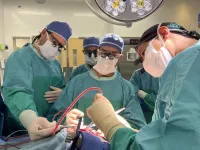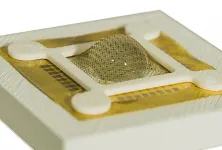(Press-News.org) BIRMINGHAM, Ala. – Millions of adults have atrial fibrillation — an irregular beating of the upper chambers of the heart that yields increased risk of heart failure, stroke and death. Many genetic mutations in the developing fetus can lead to adult atrial fibrillation, including mutations that shorten the massive protein titin in cardiac muscle cells.
Now, in a study in zebrafish and human heart muscle cells, researchers show that a tiny deletion in the A-band of titin — the loss of just nine amino acids out of more than 27,000 to 35,000 amino acids of an intact titin protein — causes a developmental defect in the embryonic heart that leads to adult arrhythmia.
Researchers at the University of Alabama at Birmingham Marnix E. Heersink School of Medicine and at the University of Illinois Chicago found that the small internal deletion in titin that led to developmental abnormalities caused unexpected ion channel remodeling in heart muscle cells, creating an increased potassium ion current called /ks (pronounced “eye k s”).
Strikingly, researchers found that pharmacologically blocking the altered /ks current improved atrial contractility in the nine amino acid-deletion zebrafish embryos, and it similarly improved contractility and prevented atrial fibrillation in the nine amino acid-deletion human cells.
“This work has potential clinical implications for both pediatric and adult patients,” said Ankur Saxena, Ph.D., a UAB associate professor in the Department of Cell, Developmental and Integrative Biology. “With titin serving as an electromechanical bridge between sarcomeric structures and ion channels, developing drug treatments targeting ion channel remodeling may restore and maintain sinus rhythm and improve contractility, as well as improve the long-term outcome for patients.”
Saxena and Dawood Darbar, M.D., of the University of Illinois Chicago, are corresponding authors of the study, published in the journal iScience.
In studying the effects of the nine-amino acid deletion in zebrafish embryos and adults as well as human induced pluripotent stem cell-derived atrial cardiomyocytes, the UAB and University of Illinois Chicago researchers discovered that zebrafish embryos homozygous for the nine-amino acid deletion showed a transient reduction in ventricular function, with smaller size, reduced contraction and slower blood circulation; however, the ventricle recovered within a few days. In contrast, embryonic and adult mutant zebrafish had persistent atrial enlargement, and adult mutant zebrafish had atrial fibrillation. In both the adult zebrafish atria and human atrial cardiomyocytes, mutated titin yielded sarcomeric disorganization and reduced contraction.
The researchers next explored how transient ventricular and persistent atrial embryonic defects mechanistically led to adult atrial fibrillation. Previous work had shown that the hormone atrial natriuretic peptide, or ANP, is overexpressed in response to ventricular dysfunction via an increased /ks, known as the slow delayed rectifier potassium current. In agreement with that, co-first authors of the study, Xinghang Jiang, a postdoctoral fellow in the UAB Department of Cell, Developmental, and Integrative Biology, and Olivia T. Ly, University of Illinois Chicago, and colleagues found aberrant ANP expression and changes in the expression of proteins that form the potassium channel in both the mutant zebrafish atria and human cardiomyocytes. Furthermore, knockdown of ANP improved atrial contraction, and voltage clamp experiments showed potassium channel remodeling, with significantly higher peak /ks density.
“Elucidating the molecular mechanisms by which developmental defects lead to increased risk of atrial fibrillation in adults has been challenging, with rare known examples,” the researchers wrote in the study. “Here, to explore the relationship between developmental defects and the pathogenesis of atrial fibrillation, we deleted just nine amino acids in titin’s A-band and identified an unexpected role for this giant protein in mediating both ion channel-dependent remodeling and impaired atrial contractility. Notably, early cardiac dysfunction and recovery lead to aberrant ANP expression and ion channel remodeling, with potential implications for how subtle structural mutations might cause subclinical abnormalities that lead to atrial fibrillation in adulthood.”
Co-authors in the study, “Transient titin-dependent ventricular defects during development lead to adult atrial arrhythmia and impaired contractility,” along with Jiang, Ly, Saxena and Darbar, are Hanna Chen, Ziwei Zhang, Beatriz A. Ibarra, Mahmud A. Pavel, Grace E. Brown, Arvind Sridhar, David Tofovic, Abigail Swick, Richard Marszalek, Fritz Navales, Salman R. Khetani, Jalees Rehman and Yu Gao, University of Illinois Chicago; and Carlos G. Vanoye and Alfred L. George Jr., Northwestern University, Chicago, Illinois.
Support came from National Institutes of Health grants HL138737, HL150586, HL148444, GM133416 and HL139439; and the UAB Heersink School of Medicine. At UAB, Cell, Developmental, and Integrative Biology is a rapidly growing basic science department in the Heersink School of Medicine.
Saxena moved to UAB from the University of Illinois Chicago last fall.
END
Tiny deletion in heart muscle protein briefly affects embryonic ventricles but has long-term effects on adult atrial fibrillation
These findings in zebrafish and human heart muscle cells have clinical implications for patients with atrial fibrillation.
2024-07-25
ELSE PRESS RELEASES FROM THIS DATE:
Harms of prescribing NSAIDs to high risk groups estimated to cost NHS £31m over 10 years
2024-07-25
Prescribing non-steroidal anti-inflammatory drugs (NSAIDs) to people at high risk of harm from them is estimated to cost the NHS in England around £31 million and cause more than 6,000 lost years of good health over 10 years, finds a study published by The BMJ today.
NSAIDs continue to be a source of avoidable harm and healthcare costs, and more needs to be done to address this, especially in high risk groups, say the researchers.
NSAIDs are used for pain and inflammation and are one of the most widely prescribed groups of medicines in the world, But they are known to increase the risk of gastrointestinal bleeding, heart attacks, stroke, and kidney damage.
Yet ...
Wearing a face mask in public spaces cuts risk of common respiratory symptoms, suggests Norway study
2024-07-25
Wearing a surgical face mask in public spaces reduces the risk of self-reported respiratory symptoms, finds a trial of adults in Norway published by The BMJ today.
The effect was moderate - a 3.2% reduction in symptoms, equivalent to around 3,300 fewer infections per 100,000 people - but the researchers say these results support the claim that face masks may be an effective measure to reduce the rate of self-reported symptoms consistent with respiratory tract infections.
Observational studies suggest that face masks reduce the risk of respiratory tract infections, but findings from randomised ...
Some private biobanks overinflating the value of umbilical cord blood banking in marketing to expectant parents
2024-07-25
Some private UK biobanks may be misleading expectant parents about the value of storing umbilical cord blood to treat life-threatening diseases that may arise in their child in the future, reveals an investigation by The BMJ, published today.
Over the past decade growing numbers of parents have chosen to store blood from the umbilical cord, which contains stem cells, in case their infant develops a condition that could be treated with stem cell therapy.
Parents must use a private biobank which charges around £550 ...
New research in fatty liver disease aims to help with early intervention
2024-07-25
A new study brings researchers closer to better understanding the pathology of the fatty liver disease MASH, which stands for metabolic dysfunction-associated steatohepatitis.
MASH is a consequence of poor diet and obesity and results in severe damage to the liver. In MASH, the liver becomes filled with active and rapidly multiplying T cells, which are a type of immune cell.
In today’s study, published in Hepatology, researchers examine what these T cells look like and how they work in people with liver cirrhosis (a late stage of liver disease) and in an animal ...
Genetics reveal ancient trade routes and path to domestication of the Four Corners potato
2024-07-25
A new study shows that a native potato species was brought to southern Utah by Indigenous people in the distant past, adding to an ever-growing list of culturally significant plant species that pre-contact cultures domesticated in the Southwestern U.S.
The team of researchers, led by Red Butte Garden and the Natural History Museum of Utah (NHMU) at the University of Utah, used genetic analysis to reveal how and where tubers of the Four Corners potato (Solanum jamesii) had been collected, transported and traded throughout the Colorado Plateau. The findings support the assertion that the tuber is a “lost sister,” joining maize, beans and squash—commonly ...
SNIS 2024: New study shows critical improvements in treating rare eye cancer in children
2024-07-25
FOR IMMEDIATE RELEASE: July 24, 2024, 3:20 P.M. MDT
CONTACT: Camille Jewell
cjewell@vancomm.com or 202-248-5460
COLORADO SPRINGS, Colo. — The evolution of retinoblastoma treatment over the past 15 years has resulted in a higher likelihood of vision preservation without compromising survival, according to research released today at the Society of NeuroInterventional Surgery’s (SNIS) 21st Annual Meeting.
Retinoblastoma, a rare eye cancer that affects young children, carries a risk of impaired vision and removal ...
Wearable devices can increase health anxiety. Could they adversely affect health?
2024-07-24
Using a wearable device, such as a smart watch, to track health data and symptoms, is supposed to help people monitor their health and address symptoms as quickly as possible to spur positive health outcomes. But for people with atrial fibrillation, also known as Afib, using a wearable device to monitor the heart rate and to alert wearers of an irregular heartbeat might not be as helpful as wearers think.
A new study in the Journal of the American Heart Association, led by Lindsay Rosman, PhD, assistant professor of medicine in the ...
Addressing wounds of war
2024-07-24
Dr. Olga Denysiuk, MD, PhD, is a highly skilled eye surgeon in Ukraine who now finds herself at the frontlines of ophthalmic trauma care caused by war.
“Every day, I am fighting my war in the operating room,” says Denysiuk. “Cases of eye trauma are mounting and it’s critical that we have surgeons trained to delicately manage eyelid and orbital injuries.”
Denysiuk is one of two ocular specialists selected for a unique humanitarian fellowship at the University of Calgary’s ...
Rice researchers develop innovative battery recycling method
2024-07-24
A research team at Rice University led by James Tour, the T.T. and W.F. Chao Professor of Chemistry and professor of materials science and nanoengineering, is tackling the environmental issue of efficiently recycling lithium ion batteries amid their increasing use.
The team has pioneered a new method to extract purified active materials from battery waste as detailed in the journal Nature Communications on July 24. Their findings have the potential to facilitate the effective separation and recycling of valuable battery materials ...
It’s got praying mantis eyes
2024-07-24
Self-driving cars occasionally crash because their visual systems can’t always process static or slow-moving objects in 3D space. In that regard, they’re like the monocular vision of many insects, whose compound eyes provide great motion-tracking and a wide field of view but poor depth perception.
Except for the praying mantis.
A praying mantis’ field of view also overlaps between its left and right eyes, creating binocular vision with depth perception in 3D space.
Combining this insight with some nifty optoelectrical engineering and innovative “edge” ...
LAST 30 PRESS RELEASES:
James Webb telescope reveals spectacular atmospheric escape
ICE-CSIC leads a pioneering study on the feasibility of asteroid mining
Dramatic rise in young people using mental health services
Be careful trusting TikTok for gout advice
A study by the University of Seville links the vanishing of the specific heats at absolute zero with the principle of entropy increase
Anxiety and insomnia may lower natural killer cell count, potentially repressing immune function
How parasitic, asexual plants evolve and live
Research spotlight: A subset of patients with depression could benefit from anti-inflammatory treatment
New fully digital design paves the way for scalable probabilistic computing
Membrane electrode assembly design for high-efficiency anion exchange membrane water electrolysis
U.S. debt ceiling disputes show measurable impact on global crude oil markets
Climate extremes triggered rare coral disease and mass mortality on the Great Barrier Reef
Direct observation reveals “two-in-one” roles of plasma turbulence
Humans rank between meerkats and beavers in monogamy ‘league table’
US fossil reveals early mass-burial event and ancient microbial attack
Sedative choice could improve outcomes for breathing tube patients
New superconducting thin film for quantum computer chips
Simulations reveal protein "dynamin" constricts cell membranes by loosening its grip
Nearly 1 in 5 UK emergency department patients cared for in corridors/waiting rooms
Heavy energy drink intake may pose serious stroke risk, doctors warn
Violence against women and children among top health threats: New global study reveals disease burden far larger than previously estimated
Predicting who is at risk of developing type 1 diabetes, as new drugs now available
New gene-mapping method unlocks hidden drivers of cancer
Ocean current and seabed shape influence warm water circulation under ice shelves
Call to increase funding for ‘invisible’ Deaf victim-survivors of domestic abuse
University of Maryland School of Medicine names distinguished scientist and academic leader Gerald M. Wilson, PhD, as Chair of the Department of Biochemistry and Molecular Biology
Receptors in mammary glands make livestock and humans inviting hosts for avian flu
Icy hot plasmas
Treating adults with autism: Maryland Clinical Center offers national blueprint for care after pediatric transition
University of Phoenix College of Doctoral Studies releases white paper on reclaiming control to build workforce resilience
[Press-News.org] Tiny deletion in heart muscle protein briefly affects embryonic ventricles but has long-term effects on adult atrial fibrillationThese findings in zebrafish and human heart muscle cells have clinical implications for patients with atrial fibrillation.






